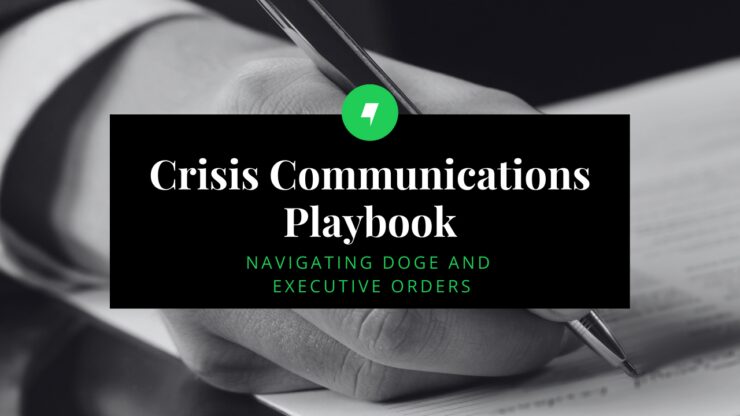Over the past several months, there has been a near constant influx of new executive orders and sweeping actions by the Department of Government Efficiency (DOGE). The impacts on businesses have been far reaching – from law firms and nonprofits to healthcare and higher education institutions – with no industry remaining comfortably insulated.
Whether your organization is bracing for federal funding cuts, reputational attacks, or sudden policy shifts, the need to have a clear, actionable communications plan at the ready has never been more important.
With an overwhelming amount of breaking news hitting inboxes and news feeds daily, getting your message visibility is more challenging than ever.
Below are several strategies to help your message get seen by necessary audiences and mobilize supporters.
1) Utilize Traditional Media Relations.
In a media landscape defined by a rapid, 24/7 news cycle, it’s more challenging than ever to secure meaningful media coverage. However, traditional media relations shouldn’t be ruled out of your communications arsenal.
The below tactics can help your organization be visible and relevant:
- Be timely: Directly tie your story to current events and policy changes. Reporters are more likely to cover stories that are relevant to the day’s headlines.
- Provide a full package: If we’ve heard one common theme from reporters recently, it’s that they’re busy – and it’s hard to keep up. We have had success making it as easy as possible for reporters to cover news by packaging a story with local data, interview spokespersons, and third-party sources to add credibility.
- Preemptive Statements: Have your company statement and media package ready to share as news breaks. In most instances, you aren’t the only organization in your industry being affected, and having all of your materials ready for rapid-fire distribution increases the likelihood you are part of the conversation.
2) Leverage Contributed Content.
Op-eds and letters to the editor (LTE) are effective strategies to help control the narrative. However, placing contributed content in high-value media targets is increasingly competitive given the volume of companies and industries being impacted by the current environment.
However, we recently had success on behalf of PA Humanities, whose executive director contributed an opinion piece to The Philadelphia Inquirer. Here’s why the placement worked:
- The op-ed was responding to breaking news the outlet was actively covering.
- Although the op-ed tied into a national story (the defunding of the National Endowment of the Humanities), it showcased local impact by connecting specific federal funding cuts to local PA Humanities’ programs.
- The piece concluded with a clear call to action, inviting readers and supporters of the humanities to call their representatives and voice opposition to the cuts.
If an op-ed or LTE isn’t an option in your media market (or isn’t accepted), this type of first-person content can still be valuable – for example, try self-publishing on LinkedIn to reach your networks directly.
3) Flood the Zone on Owned Channels.
If your company, your team, or board is active on social media, one of your most powerful communication vehicles is already at your fingertips. Increase awareness by:
- Blasting all media coverage, written content, and appropriate communications materials across social media platforms.
- Utilizing social media best practices, like tagging and hashtagging, to optimize reach and visibility.
- Encouraging staff, partners, supporters, and board members to amplify this content with their own networks.
4) Activate Your Board & Advocates.
Your board members, clients, partners, and industry peers can be influential messengers. Make their job easier, and ensure a cohesive and unified message, by equipping them with plug and play materials. For example:
- Pre-packed social media content
- Email newsletter templates and resources (e.g. sample scripts if encouraging your audience to call their representative)
- Talking points and sample Q&As, as needed
5) Define Your Call to Action.
Raising awareness is only half the battle. Now that you have your audience’s attention, what is your goal? For example, do you want to encourage supporters to contact their local representatives? Sign a petition? Request donations?
Successful crisis communications, especially when responding directly to a negative government action, means having a clear call to action to support your end goal.
In today’s unpredictable business climate, uncertainty is the only constant. Regardless of industry, being prepared for a crisis now can help your organization better navigate potential situations down the road.
Interested in reading more about crisis communications from the Maven team? Check out “The Time for Scenario Planning is Now” and “The Importance of Message Consistency in a Crisis.”
Posted In Crisis Communications
 Emily White
Emily White 